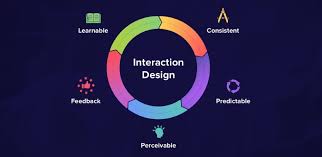The Art of Interaction Design
Interaction design is a crucial discipline that focuses on creating engaging and intuitive user experiences across digital platforms. It involves designing the way users interact with technology, aiming to make these interactions seamless, efficient, and enjoyable.
At its core, interaction design is about understanding user needs and behaviours to design interfaces that meet those requirements effectively. It encompasses a range of elements, including visual aesthetics, usability, accessibility, and functionality.
The Principles of Interaction Design
Effective interaction design follows several key principles:
- User-Centred Design: Putting the needs and preferences of users at the forefront of the design process.
- Consistency: Maintaining uniformity in design elements to create a cohesive user experience.
- Feedback: Providing users with clear responses to their actions to enhance usability.
- Simplicity: Striving for simplicity in interface design to reduce cognitive load on users.
- Accessibility: Ensuring that interfaces are accessible to users of all abilities.
- Interactivity: Encouraging user engagement through interactive elements such as animations, transitions, and gestures.
The Role of Interaction Designers
Interaction designers play a pivotal role in shaping digital experiences by translating user needs into functional and visually appealing interfaces. They collaborate closely with user researchers, graphic designers, developers, and other stakeholders to create seamless interactions that delight users.
By employing user research methods, prototyping tools, and usability testing techniques, interaction designers iterate on designs to refine them based on user feedback. Their goal is to create intuitive interfaces that anticipate user actions and respond effectively to enhance overall usability.
The Future of Interaction Design
As technology continues to evolve rapidly, the field of interaction design is poised for exciting advancements. Emerging trends such as voice interfaces, augmented reality (AR), virtual reality (VR), and artificial intelligence (AI) are reshaping how users interact with digital products.
Interaction designers must adapt to these changes by staying informed about new technologies and designing experiences that leverage these innovations effectively. By embracing creativity, empathy for users, and a deep understanding of human-computer interactions, interaction designers can shape the future of digital experiences in meaningful ways.
“The Role and Responsibilities of an Interaction Designer”
“Various Domains within the Field of Interaction Design”
4. “Understanding the Methodologies Employed in Interaction Design
- What is interactive design examples?
- What is the job of interaction design?
- What are the fields of interaction design?
- What is the method of interaction design?
What is interactive design examples?
Interactive design encompasses a wide range of examples that showcase the dynamic and engaging nature of user interactions with digital interfaces. Some common interactive design examples include responsive websites that adapt to different screen sizes, mobile apps with intuitive gesture controls, interactive maps that allow users to explore locations seamlessly, e-learning platforms with engaging quizzes and animations, and immersive virtual reality experiences that transport users to new worlds. These examples demonstrate how interactive design enhances user engagement, usability, and overall user experience across various digital platforms.
What is the job of interaction design?
The job of interaction design revolves around creating user-centric digital experiences that are intuitive, engaging, and efficient. Interaction designers focus on understanding user behaviours, needs, and preferences to design interfaces that facilitate seamless interactions with technology. They collaborate with multidisciplinary teams to translate user insights into visually appealing and functional designs. By incorporating principles of usability, accessibility, and interactivity, interaction designers aim to craft interfaces that enhance user satisfaction and overall usability. Their role is to bridge the gap between users and technology by designing interfaces that anticipate user actions and provide meaningful feedback, ultimately shaping the way individuals engage with digital products and services.
What are the fields of interaction design?
Interaction design encompasses a diverse range of fields that play a crucial role in shaping user experiences across various digital platforms. Some key fields within interaction design include user interface design, user experience design, information architecture, usability engineering, and human-computer interaction. User interface design focuses on creating visually appealing and functional interfaces that enable users to interact with digital products effectively. User experience design involves understanding user behaviours and emotions to enhance the overall experience of using a product or service. Information architecture deals with organising and structuring content in a way that is intuitive and easy to navigate. Usability engineering aims to improve the usability of interfaces through testing and iterative design processes. Human-computer interaction explores the relationship between humans and technology, seeking to create seamless interactions that meet user needs and expectations. Each of these fields contributes uniquely to the multidisciplinary practice of interaction design, shaping the way we engage with technology in our daily lives.
What is the method of interaction design?
The method of interaction design involves a systematic approach to creating intuitive and user-friendly interfaces for digital products. Interaction designers typically follow a structured process that includes researching user needs, defining design goals, creating prototypes, testing usability, and iterating on designs based on feedback. By understanding user behaviours, preferences, and contexts of use, interaction designers can develop interfaces that facilitate seamless interactions between users and technology. This methodical approach ensures that the final design meets the needs of users while delivering a satisfying and engaging experience across various digital platforms.
